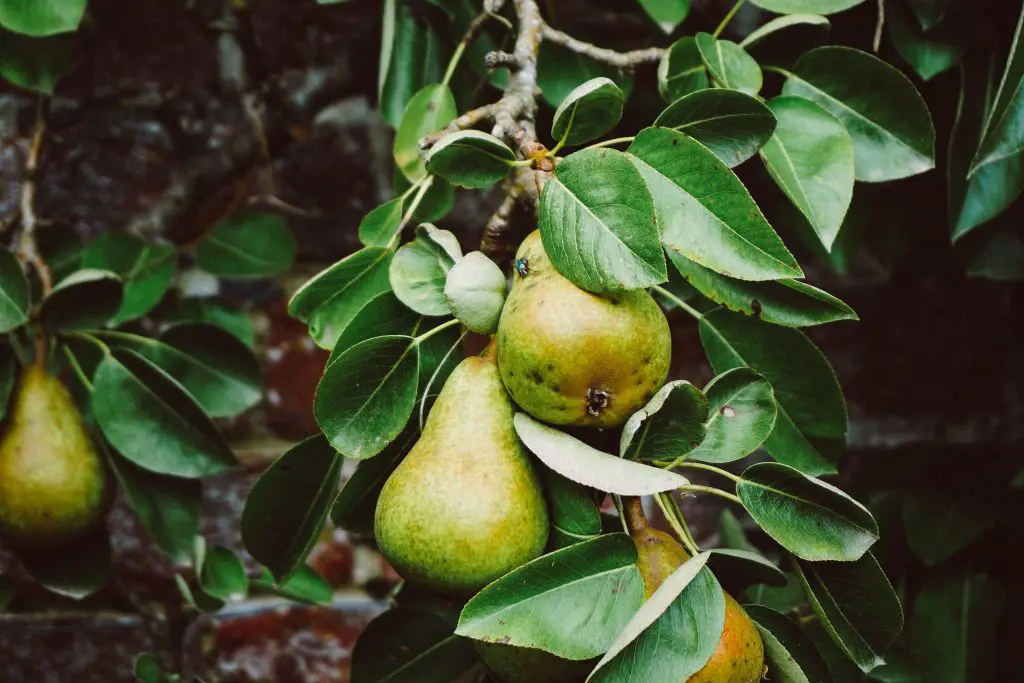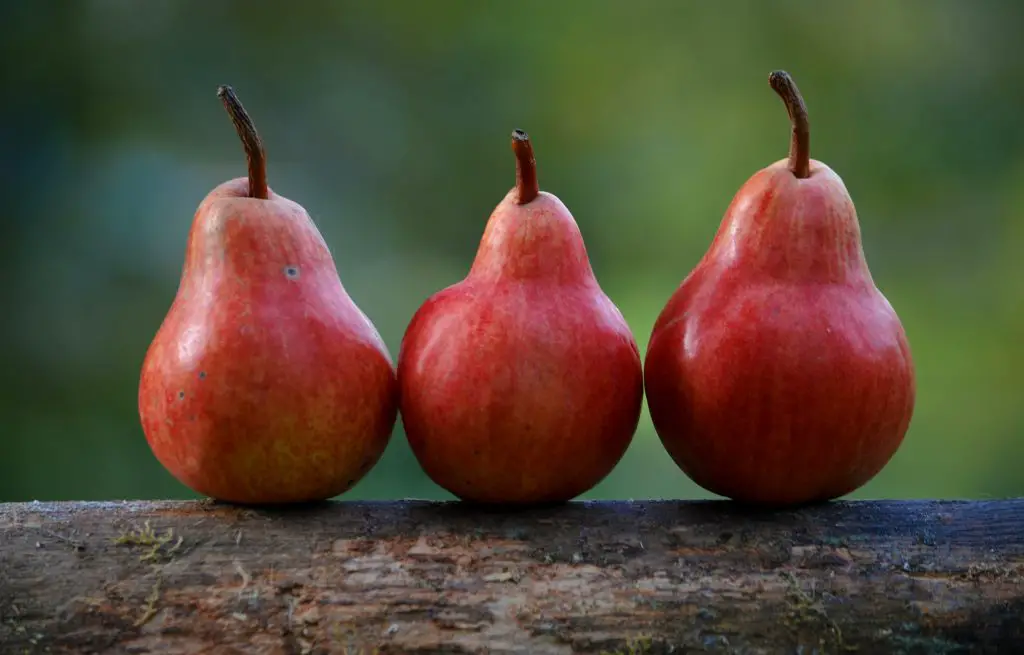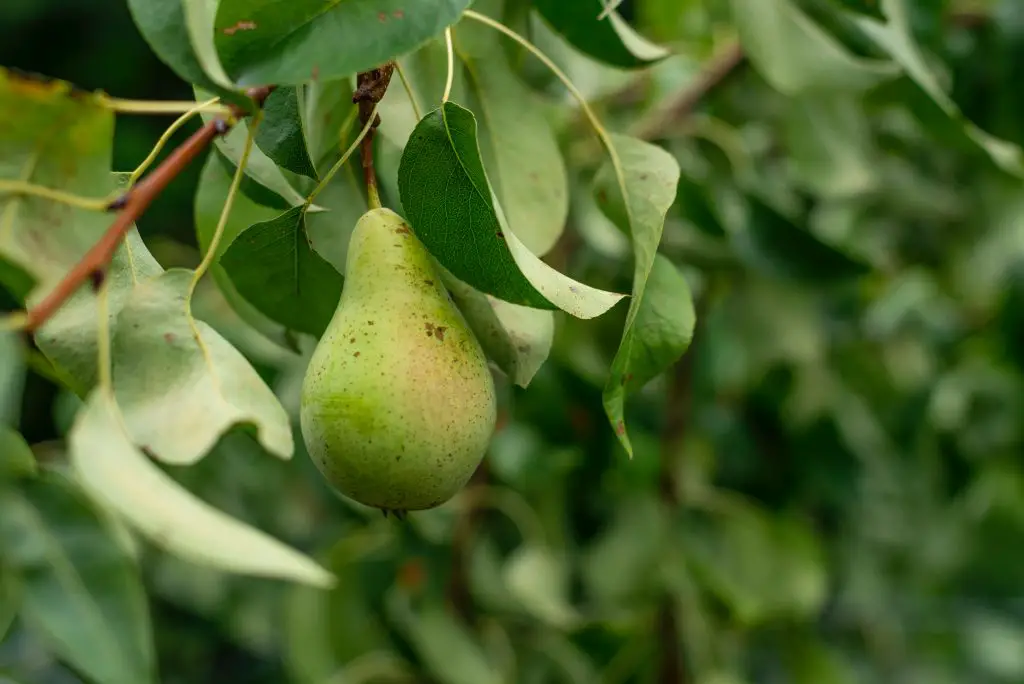How Many Pears Does A Tree Produce? Pears are one of the most widely cultivated fruits, and they have been grown for centuries in places like the UK. They are a delicious summer treat when picked straight from the tree and are well worthwhile growing in your own yard.
A mature Pear tree will produce up to 150 lbs (70 kg) of fruit in a season, however, for that size of crop the tree needs to be very large making the harvesting of fruit very difficult for the home gardener. However, if the tree is restricted in size via a training system such as an espalier around 45 lbs (20 kg) may be expected according to a Cornell University study.
The study indicated that these types of yield could be achieved irrespective of the train system used provided that the trees were not planted too close together. A spacing of less than 3 to 4 ft started to have detrimental effects on the yield achieved.
However, achieving a yield of 45 lbs will take around 4 to 6 years depending on the variety and training method used. The first harvest, which is generally relatively modest, will appear after 2 to 3 years.
Are There Different Types Of Pear Varieties?
Pears can be divided into two major groups, European and Asian. European pears have the traditional shape that everyone associates with Pears and these varieties soften as they ripen, whereas Asian pears remain crispy when ripe. Additionally, Asian Pears are typically a round apple-like shape and are not as cold hardy as European Pears.

Pears are most suited for growing in zones 4 to 9, however, there are some varieties that will tolerate zone 3 conditions such as Southworth, Summer Crisp, and Lorna. There are also selected varieties that will tolerate conditions in zone 10, such as Monterrey, Flordahome, and Hood.
The limiting factor in warmer regions is not the survival of the tree but rather the ability to produce flowers and subsequently fruit. To produce flowers Pears require a period of cool in winter, which is commonly referred to as chill hours. This is the number of hours, under 45°F (7°C) that a tree needs to be exposed to in order to produce fruit.
To assess the suitability of a given variety, in a particular region it is necessary to estimate the number of chill hours. To do this take the average temperature in your coldest month and compare it to the table provided below.
Chill Hours Average Temperature For Coldest Month
0 19.7°C (67.5°F) – No Chill
300 15.5°C (59.9°F) – Low Chill
330 15.3°C (59.5°F) – Low Chill
450 14.0°C (57.2°F) – Medium Chill
500 13.6°C (56.5°F) – Medium Chill
520 13.1°C (55.6°F) – Medium Chill
600 12.7°C (54.9°F) – Medium to High Chill
800 10.2°C (50.4°F) – High Chill
1100 7.9°C (46.2°F) – High Chill
1250 0.0°C (32.0°F) – Very High Chill
For those that live in zone 9 or 10, it is best to grow Asian pears as they are relatively low chill varieties. However, these varieties are also only usually hardy to Zone 5.
Do You Need Two Pear Trees To Produce Fruit?
When growing Pears, in most cases two different cultivars are required in most cases to ensure successful pollination and fruit. However, for cross-pollination to occur both varieties of trees need to flower at the same time or at the very least have overlapping flowering periods.
To simplify the selection of trees Pears are often grouped from A to D based on the timing of the flowering, with A being the earliest to flower while D is the lastest. The pollination groups can fertilize other trees within the same group and those next to them.
For example Group A trees can pollinate other trees in Groups A and B, whereas Group B can pollinate Groups A, B, and C because the flowering period of Group B overlaps with Group A in the early stages and Group C in the later stages of flowering.
A list of common varieties of Pears is provided, with groups, in the table below. However, it is important to note that the timing of flowering is not related to timing of the harvest. ie An early flowering variety is not necessarily an early fruiting variety.
This is advantageous as it allows early and late fruiting varieties to be selected that can pollinate each other, and also extend the harvest period.
| Name | Harvest Period | Pollination Group | Comments |
|---|---|---|---|
| Conference | Mid- Season | A | Pollinates Group A & B trees |
| Louise Bonne of Jersey | Mid- Season | A | Pollinates Group A & B trees (Except Williams Bon Chretien) |
| Beth | Early-Season | B | Pollinates Groups A, B & C |
| Beurre Hardy | Mid- Season | B | Pollinates Groups A, B & C (A poor pollinator for other pears) |
| Brandy | Mid- Season | B | Pollinates Groups A, B & C |
| Glou Morceau | Mid- Season | B | Pollinates Groups A, B & C |
| Merton Pride | Early-Season | B | Pollinates Groups A, B & C (Cannot pollinate other trees) |
| Williams bon Chretien | Early-Season | B | Pollinates Groups A, B & C (Except Louise Bonne of Jersey) |
| Winter Nelis | Late-Season | B | Pollinates Groups A, B & C |
| Cannock | Mid- Season | C | Pollinates Groups B, C & D |
| Concorde | Mid- Season | C | Pollinates Groups B, C & D |
| Doyenne du Comice | Mid- Season | C | Pollinates Groups B, C & D (Except Onward) |
| Humbug | Late-Season | C | Pollinates Groups B, C & D |
| Invincible | Mid- Season | C | Pollinates Groups B, C & D |
| Onward | Mid- Season | C | Pollinates Groups B, C & D (Except Doyenne du Comice) |
| Sensation | Early-Season | C | Pollinates Groups B, C & D |
| Hellens Early | Mid- Season | D | Pollinates Groups C & D |
While most Pears are not self-fertile that are a few varieties that can be planted by themselves. The two best performers of this type are Conference and Concorde. There are also several other varieties that are partially self-pollinated which means they will produce some fruit however without another variety to pollinate them the size of the crop will be small.

How To Grow A Pear Tree
Pear trees can generally be planted year-round in most regions however, the best time by far is in late winter or early spring. The reason for this is that it provides an opportunity for a newly planted tree’s root system to become established before the summer heat arrives. Additionally, at this time of year Pear trees can be purchased as bare-rooted plants which is much cheaper than purchasing potted plants.
Once the tree has been selected and purchased the next important step is to select a location. Ideally, Pear trees are best planted in a location that gets at least 8 hours of sun per day. It is also preferred that the location be shielded from high winds that can affect the rate of pollination.
The next important consideration is the soil conditions, Pear trees prefer well-drained soil that contains plenty of organic matter and is slightly acidic. A pH between 6 and 7 is ideal, to measure this it is best to use a pH meter rather than a pH kit with strips. Meters are easier to use and cheaper, click here to see the latest price on Amazon.
In some cases, it may be necessary to add compost to the soil to increase the available nutrients for the tree. Any compost that is added should be dug into the soil before digging the planting hole. Once the plant hole has been created it is best to hammer a stake into position to avoid the need to add one later and potentially damage the roots.
At this stage, the tree should be placed in the hole at a depth approximately equal to the level the tree had previously been in the ground. Backfill the hole with soil, and firm the soil down as you go to avoid any chance of air pockets forming around the root-ball.

Once the hole is completely filled water the tree in well and cover the surrounding soil with a thick layer of organic mulch, 2 to 4 inches is ideal.
At this point, the tree needs to be pruned to ensure that the tree develops a vase-like shape as this will allow sunlight and air to penetrate the structure. This aids in the formation and ripening of fruit and reduces the chances of a fungal disease taking hold.
To create this shape trim the branches to a height of 1 to 2 ft (30 to 60 cm) above where the branches fork. The cut should be made just above an outward-facing bud. The cuts will encourage the tree to produces lots of new wood.
Once the pruning is complete attach the tree trunk to the stake using tree ties. The ties should be made of soft flexible material to ensure the tree branches have the ability to expand in width over time.
How to Care for a Pear Tree
In the first growing season after planting Pear trees are particularly susceptible to drying out. As such it is important to ensure that the tree is regularly watered, particularly in the height of summer when there are frequent dry spells. We recommend watering once or twice a week in these periods.
In addition to watering, trees should be fertilized in early spring with a slow-release fertilizer. This will ensure that there are adequate nutrients throughout the growing season.
Additionally, Pear trees should be pruned in winter to maintain the structure and encourage new growth. To maintain the vase-like shape the first step is to remove inward-facing branches to ensure that the light and air are able to enter the structure of the tree easily, along with any diseased or damaged branches. The height of the remaining branches should be reduced to a 1 ft above any forks to continue to develop the structure.
However, once the structure of the tree has developed sufficiently it will be necessary to maintain the tree at a height that allows the fruit to be harvested easily.
